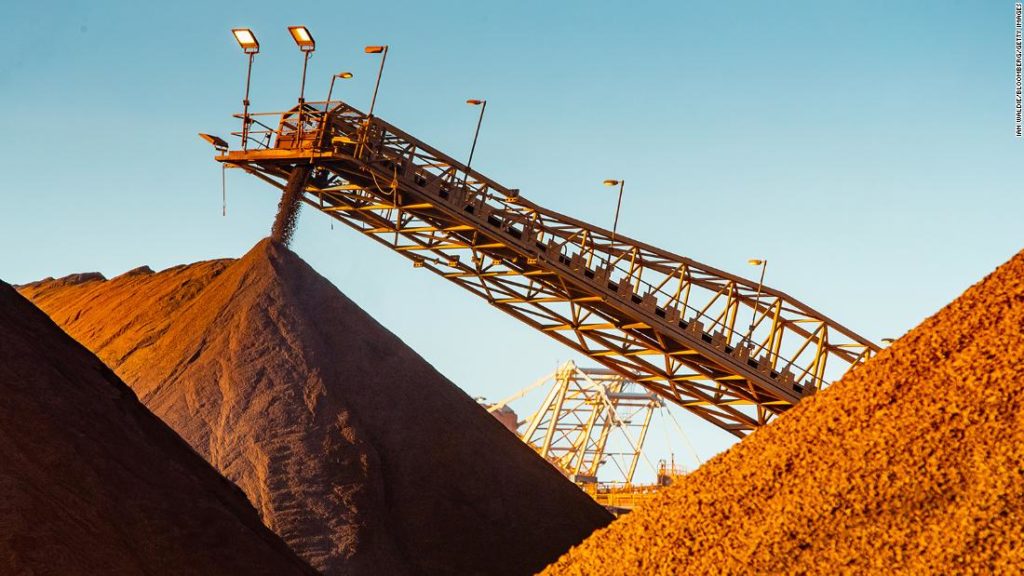Now, one commodity is almost single-handedly keeping the trade relationship afloat: iron ore.
Diplomatic relations between Australia and China fell into a deep chill one year ago, after Prime Minister Scott Morrison called for an independent investigation into the origins of the Covid-19 pandemic which threatened to challenge Beijing’s narrative of the viral outbreak.
But experts said that unlike wine and coal, it would be tough for China to find new sources of iron ore any time soon. That means Australia’s largest source of trade revenue may be secure.
“Australia is the largest iron ore producer in the world and on the other hand China is the largest steel producer in the world,” said Heiwai Tang, professor of economics at Hong Kong University Business School.
“It isn’t that easy for them to get into a new round of trade wars over this particular product.”
The mining boom
For more than two decades, China and Australia have helped rapidly grow each others’ economies through a soaring trade in raw resources, especially iron ore and coal.
The lack of diversity in Australia’s exports leaves it vulnerable to any major impact on its main sources of revenue, experts said. And while there could be other markets for the country’s iron ore, they might take time to develop.
“China’s making up around four-fifths of Australian iron ore exports, so what that tells me is we don’t have too many other destinations that we do business with in a big way,” said Sean Langcake, principal economist at BIS Oxford Economics in Sydney.
But economists said while Australia may eventually locate new buyers for its iron ore, it would be much more difficult for China to find new sources of iron ore to power its economy.
Alternate sources
Experts said Australia’s iron ore has two main advantages for Chinese buyers: it is high quality and reliable.
Australia produces a higher amount of hematite iron ore than any other country, which contains a larger quantity of usable iron than itabirite or magnetite. According to lobbying group the Minerals Council of Australia, hematite usually contains more than 50% iron compared to as low as 16% in magnetite.
Economist Langcake said it was easier and cheaper to process ore with a higher iron content, making it more attractive to steel producers.
“With China still experiencing significant growth and new frontiers expanding in South and East Asia, Australia’s standing as a low-cost, reliable supplier of quality iron ore puts it in a strong position to continue as a provider of choice for global steel makers,” Minerals Council chief executive officer Tania Constable said in a statement.
At the same time, experts said Australia was a regular and reliable supplier of iron ore to China, partly due to its stable political system and economic environment.
While Brazil seems like it would be a natural alternate source for China’s iron ore, its production has been damaged over the past decade due to a series of disasters which have disrupted major mines.
Shane Oliver, chief economist at AMP Capital in Australia, said Brazil’s poor handling of the coronavirus pandemic in 2020 and 2021 has also set back production, while Australia had mostly brought the disease under control.
“It is virtually impossible for China to replace Australian iron ore in the short term,” Oliver said. “They’d still have a short fall … It took a long time for Australia to build up so it will take a long time for other countries to do [the same].”
‘Economic losses and political gain’
Even the valuable trade hasn’t been able stop calls from both countries to diversify their iron ore business.
“India, Vietnam and Indonesia, in particular, present valuable opportunities for Australian businesses. As such, ensuring access to these markets should continue to be a priority for the Australian Government,” the report said.
It quoted an expert who said that Australia’s move to help the United States “contain China” had “seriously lowered Chinese companies’ favorable assessment of Australia.”
Both Langcake and Oliver said it was likely both China and Australia would look to diversify their trade relationships slowly over the coming decades, given the growing political divide between the two countries.
But with the iron ore trade likely to continue as a major driver for economic growth in both China and Australia, the two countries might be stuck with each other for the foreseeable future.
Tang, from Hong Kong University, said diplomatic ties between the two countries could only deteriorate so much when they were still linked by iron ore.
“It’s really a calculation between economic losses and political gain … I think there would be some overall constraints on how far they can go,” he said. “I remain optimistic.”
You may also like
-
Afghanistan: Civilian casualties hit record high amid US withdrawal, UN says
-
How Taiwan is trying to defend against a cyber ‘World War III’
-
Pandemic travel news this week: Quarantine escapes and airplane disguises
-
Why would anyone trust Brexit Britain again?
-
Black fungus: A second crisis is killing survivors of India’s worst Covid wave

